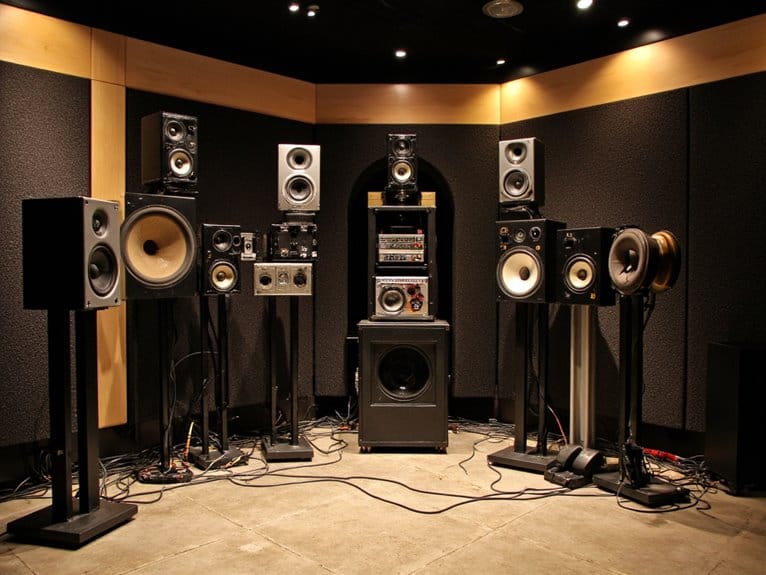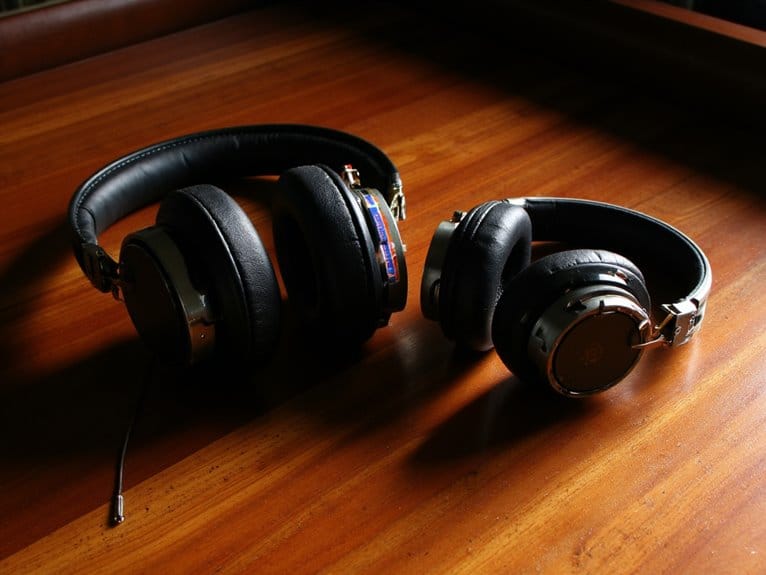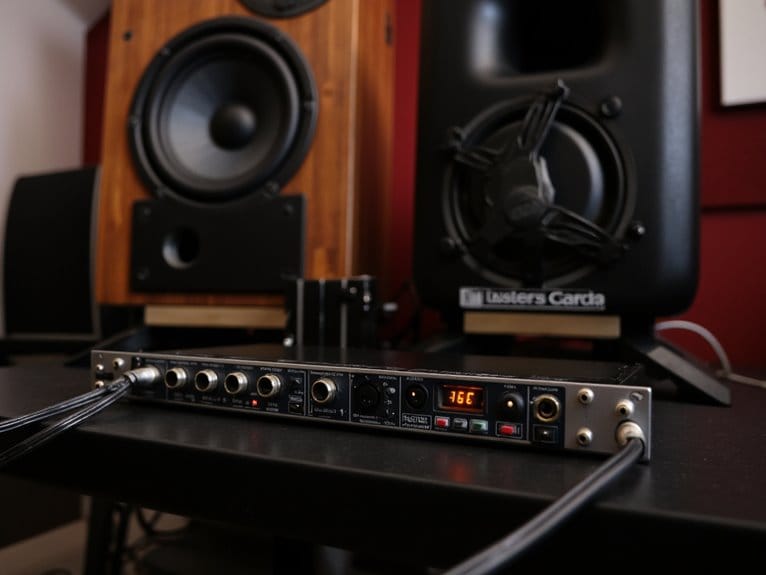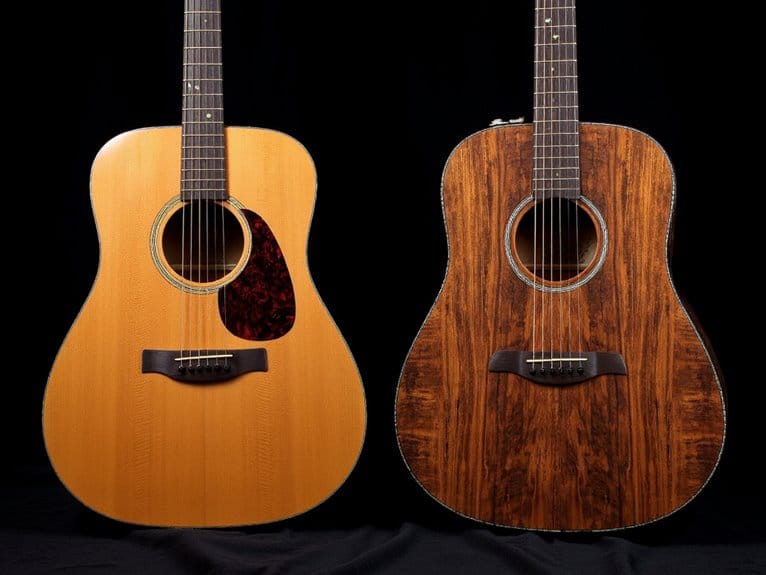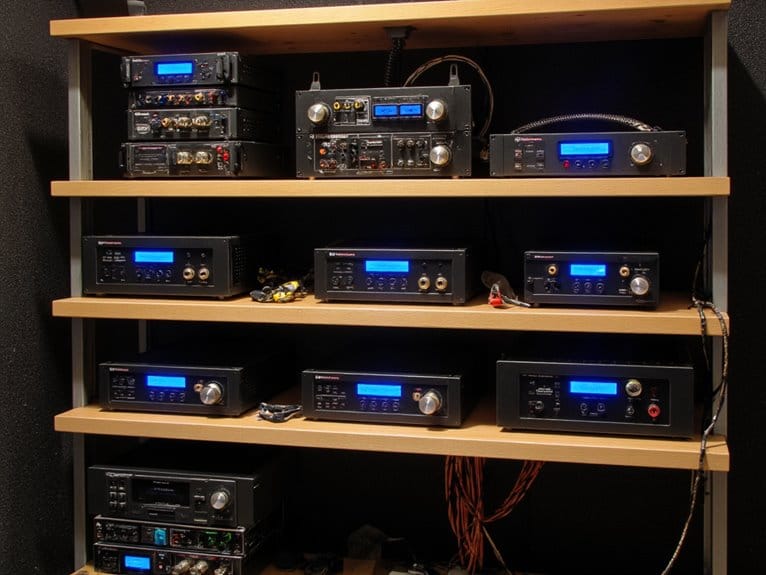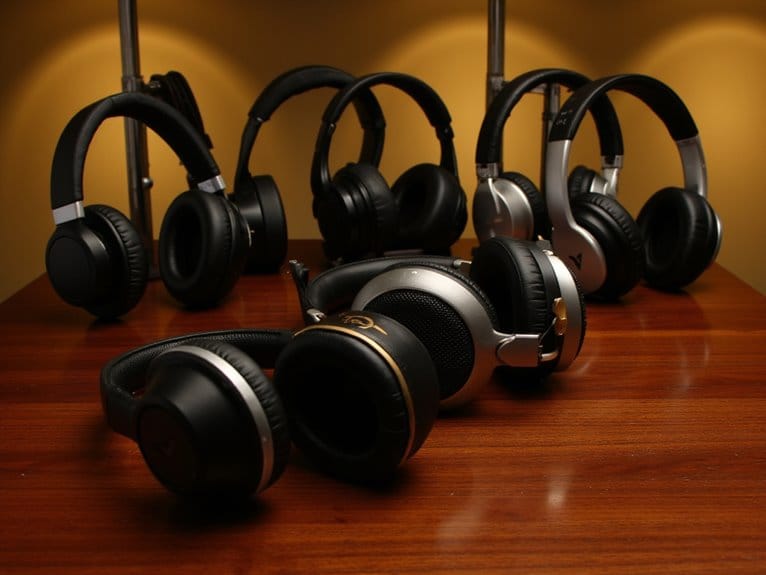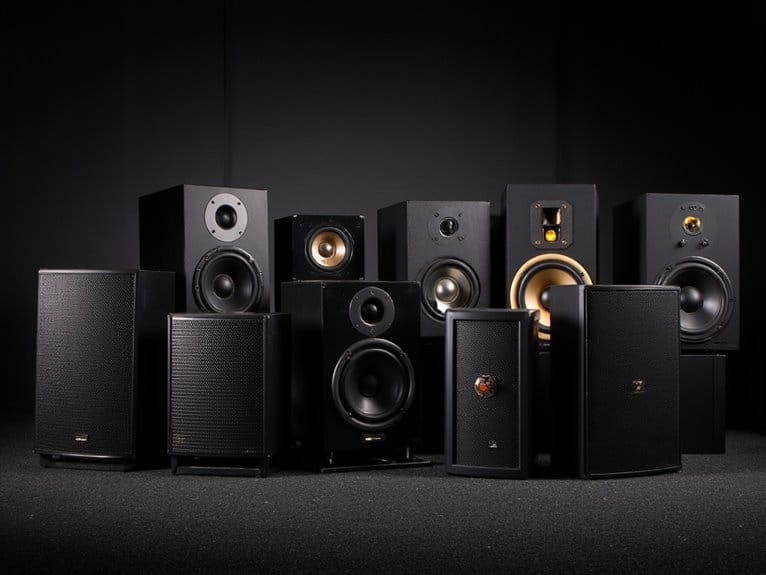10 Best Studio Monitors for Professional Audio Production
After testing numerous models, I’ve found the standout monitors include the PreSonus Eris 3.5BT with its 50W Class AB amplification and Bluetooth 5.0, the budget-friendly Edifier MR4 offering dual-mode design at $129, and the Yamaha HS3 providing flat response from 70Hz-22kHz. The Ortizan C7 impresses with carbon fiber drivers and 24-bit DAC, while Mackie CR3.5 delivers surprising accuracy in compact form. Each model balances professional accuracy with space constraints, though specific considerations will guide your ideal choice.
We are supported by our audience. When you purchase through links on our site, we may earn an affiliate commission, at no extra cost for you. Learn more.
Notable Insights
- Professional studio monitors require flat frequency response, accurate sound reproduction, and robust amplification for reliable mixing and mastering work.
- Compact models like PreSonus Eris 3.5BT and Edifier MR4 deliver studio-quality sound while fitting smaller production spaces effectively.
- JBL Professional 305P MkII features patented waveguide technology and enhanced transducers, backed by a comprehensive 5-year warranty.
- Yamaha HS5 offers bi-amplified design with 70 watts power and flat 54Hz-30kHz frequency response for precise audio monitoring.
- Key selection factors include driver configuration, power rating, connectivity options, and acoustic tuning controls for room optimization.
PreSonus Eris 3.5BT Studio Monitors (3.5 Inch Powered Bookshelf Speakers)
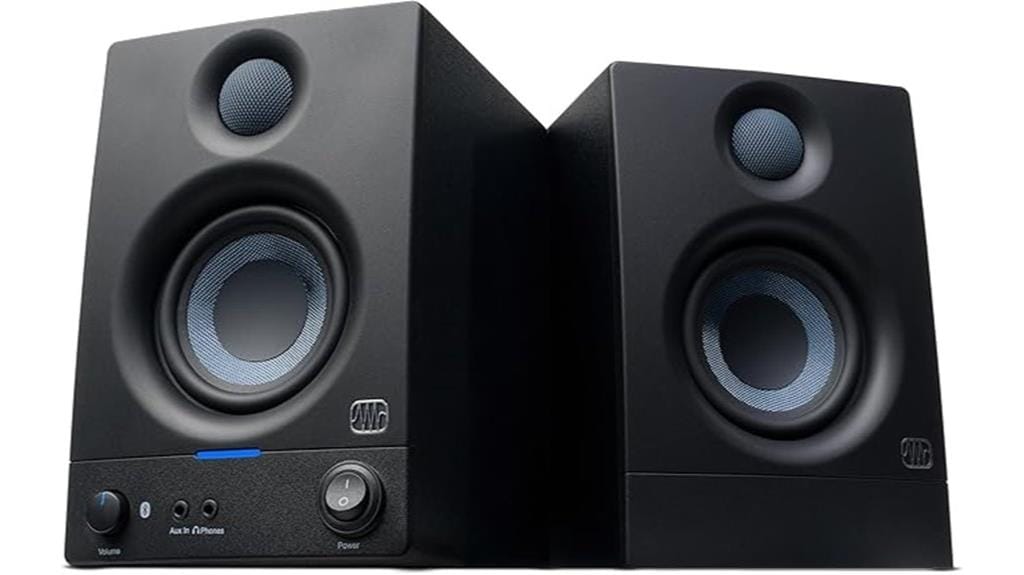
If you’re searching for compact studio monitors that won’t break the bank but still deliver professional-grade audio accuracy, the PreSonus Eris 3.5BT Studio Monitors represent one of the most compelling entry points into serious audio production. These diminutive powerhouses pack 50 watts of Class AB dual amplification into a surprisingly compact 5.5D x 6W x 8.3H inch footprint, making them ideal for cramped home studios, dorm rooms, or desktop setups where space comes at a premium. The woven-composite woofers deliver tight bass response while silk-dome tweeters create an ultra-wide listening sweet spot, ensuring your mixes translate accurately across different playback systems.
Best For: Home studio enthusiasts, content creators, and desktop users seeking professional-grade audio accuracy in a compact, budget-friendly package for music production, gaming, and multimedia applications.
Pros:
- Delivers studio-quality sound with 50W Class AB dual amplification and acoustic tuning controls for customizable frequency response
- Versatile connectivity including Bluetooth 5.0, balanced TRS inputs, RCA inputs, and integrated headphone amplifier
- Compact design that fits any desk while providing room-filling sound and an ultra-wide listening sweet spot
Cons:
- Mediocre quality included cables that may need upgrading for optimal performance
- Cheaper cabinet build quality compared to higher-end studio monitors
- Limited low-end response due to 3.5-inch driver size constraints
Ortizan C7 Dual-Mode 2.0 Studio Monitor Speakers (Pair, Black)
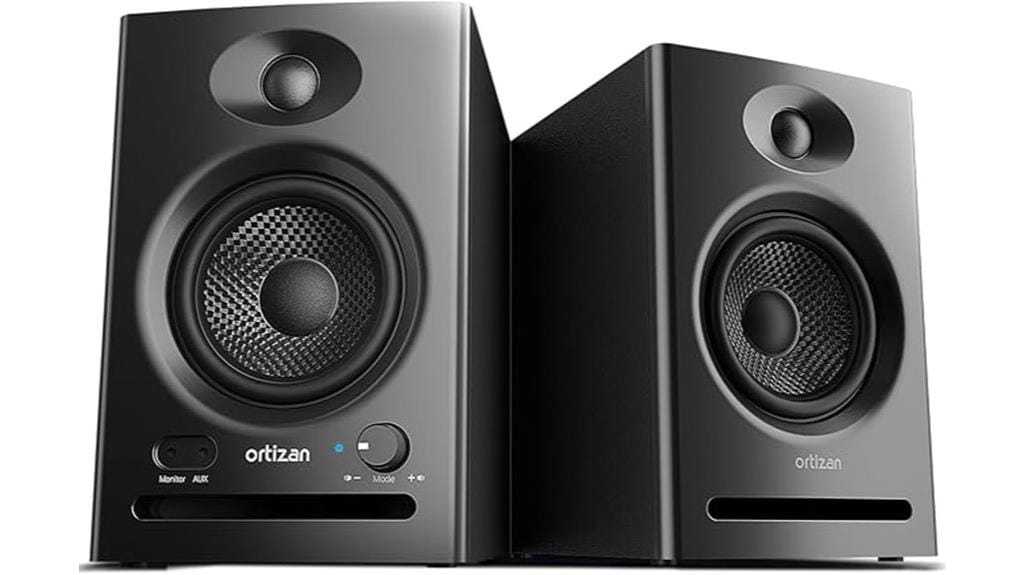
The Ortizan C7 Dual-Mode 2.0 Studio Monitors excel as entry-level production speakers that won’t demolish your budget while delivering surprisingly competent sound reproduction for home studios, bedroom producers, and content creators who need reliable monitoring without the premium price tag. You’ll get 3.5-inch carbon fiber drivers paired with silk dome tweeters, plus a built-in 24-bit DAC that maintains signal integrity throughout your audio chain. The dual-mode connectivity includes Bluetooth 5.3 for wireless convenience and traditional RCA, AUX, and TRS balanced inputs for professional applications, while front-panel bass and treble controls let you dial in your preferred sound character without reaching around back.
Best For: Entry-level music producers, content creators, and home studio enthusiasts who need reliable monitor speakers with both wired and wireless connectivity options at an affordable price point.
Pros:
- Dual-mode connectivity with Bluetooth 5.3 and professional wired inputs (RCA, AUX, TRS balanced) offers versatility for different use cases
- Built-in 24-bit DAC and flat response tuning deliver accurate sound reproduction suitable for mixing and monitoring at this price range
- Front-panel bass and treble controls with convenient volume knob provide easy sound adjustment without accessing rear connections
Cons:
- Limited cable lengths included in the package may require additional purchases for some setups
- Manual documentation lacks clarity and could be more comprehensive for new users
- Compact 3.5-inch drivers may not provide sufficient low-end extension for genres requiring deep bass monitoring
Edifier MR4 Powered Studio Monitor Speakers (White Pair)
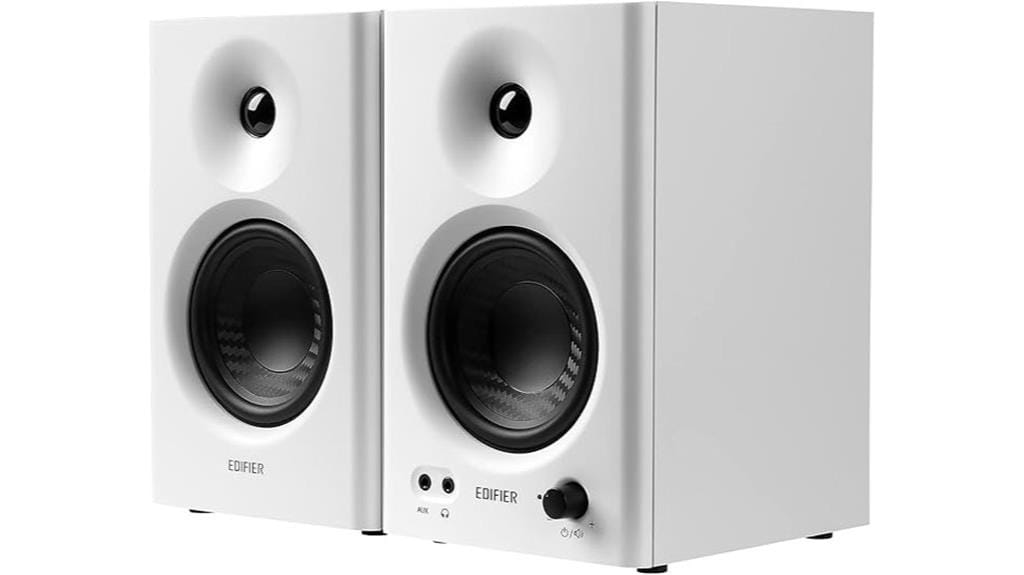
Budget-conscious producers and content creators who want genuine studio monitor performance without breaking the bank will find the Edifier MR4 Powered Studio Monitor Speakers particularly compelling, especially since they deliver true near-flat frequency response at just $129 for the pair. You’ll appreciate the dual-mode design that switches between monitor mode for precise production work and music mode for enhanced bass during casual listening. The 1-inch silk dome tweeters paired with 4-inch composite woofers create a surprisingly wide soundstage, while the MDF wooden construction effectively minimizes resonance that could color your mixes. Though the high-end lacks some crispness compared to pricier alternatives, these monitors offer balanced 1/4-inch TRS and RCA connectivity options.
Best For: Budget-conscious producers, content creators, and casual listeners who want genuine studio monitor performance with dual-mode functionality for both precise production work and enhanced leisure listening without spending more than $130.
Pros:
- True near-flat frequency response with dual-mode design (monitor/music modes) and wide soundstage from 1-inch silk dome tweeters and 4-inch composite woofers
- Multiple connectivity options including balanced 1/4-inch TRS, RCA, and AUX inputs with front headphone output and separate high/low frequency adjustment knobs
- MDF wooden construction minimizes resonance and delivers significantly better sound quality than typical computer speakers at an affordable $129 price point
Cons:
- High-end frequencies lack some crispness and clarity compared to more expensive studio monitor alternatives
- Light distortion may occur in mid to high frequency ranges during certain listening conditions
- Limited signal-to-noise ratio at 85 dB may not meet the standards required for professional-level audio production work
SW208 3 Active Bluetooth 5.0 Bookshelf Speakers (Pair, White)

Compact audio enthusiasts searching for wireless convenience without sacrificing sound clarity will find the SW208 3 Active Bluetooth 5.0 Bookshelf Speakers deliver surprisingly robust performance for their modest 3-inch driver configuration. The carbon fiber drivers, paired with multi-layer voice coil technology, produce warm mids and clear highs that’ll satisfy casual listeners, though audiophiles might notice limitations with compressed formats like MP3. You’ll appreciate the built-in 24-bit DAC and adjustable treble/bass controls, while Bluetooth 5.0 guarantees stable wireless transmission up to 30 feet without noticeable lag during gaming sessions or video calls.
Best For: Casual listeners, gamers, and users seeking compact wireless speakers for everyday use including video calls, gaming, and general entertainment who prioritize convenience and aesthetic appeal over audiophile-grade sound quality.
Pros:
- Carbon fiber drivers with 24-bit DAC and adjustable treble/bass controls deliver clear, customizable sound with stable Bluetooth 5.0 connectivity up to 30 feet
- Compact, lightweight design with elegant wood finish that saves space and blends well with any decor
- Energy-efficient operation with intelligent noise filtering during standby and reliable performance for gaming and video calls
Cons:
- Limited performance with compressed audio formats like MP3, requiring lossless formats like FLAC for optimal sound quality
- Occasional connectivity issues reported with the 3.5mm auxiliary input jack
- 3-inch drivers may not satisfy audiophiles or users seeking powerful bass response for music-focused applications
PreSonus Eris 3.5 Studio Monitors (Powered Active Speakers)
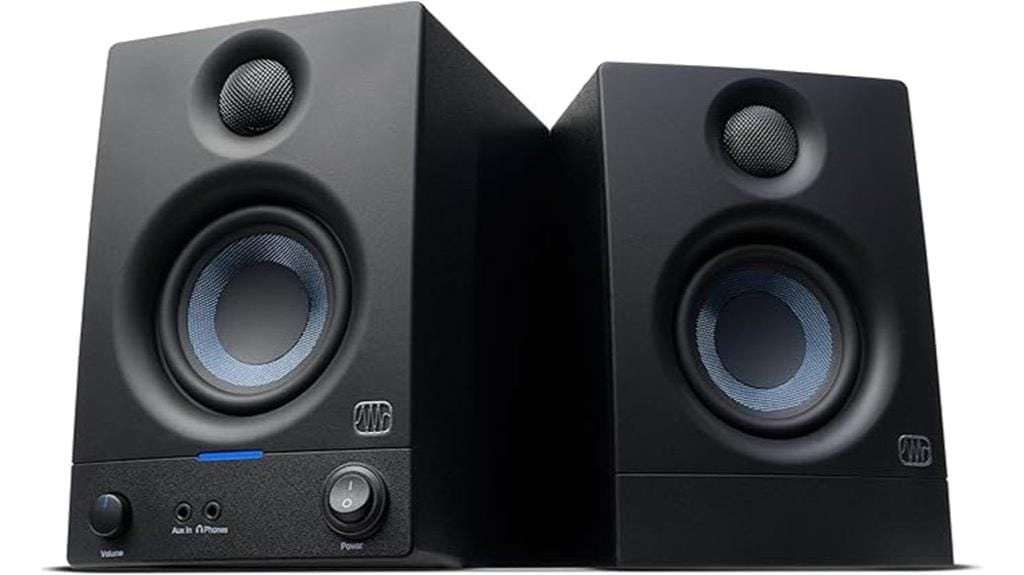
When you’re working in tight spaces but refuse to compromise on professional audio quality, PreSonus Eris 3.5 Studio Monitors deliver studio-grade sound in a remarkably compact package that’s perfect for home producers, content creators, and audiophiles with limited desk real estate. These powered speakers pack 50 watts of Class AB amplification into dimensions measuring just 5.5″ deep by 6″ wide by 8.3″ high, featuring woven-composite woofers for tight bass response and 1-inch silk-dome tweeters that create superior stereo imaging with an ultra-wide listening sweet spot. You’ll appreciate the front-panel 1/8″ auxiliary input alongside balanced TRS and unbalanced RCA connectivity options.
Best For: Home producers, content creators, and audiophiles working in small spaces who need professional studio-quality sound without compromising on accuracy or taking up extensive desk real estate.
Pros:
- Studio-grade audio quality with 50W Class AB amplification, woven-composite woofers for tight bass, and silk-dome tweeters delivering superior stereo imaging in a compact design
- Versatile connectivity options including balanced TRS, unbalanced RCA, and convenient front-panel auxiliary input for multiple device compatibility
- High- and low-frequency tuning controls allow precision customization of audio output based on room acoustics and personal preferences
Cons:
- Not suitable for larger rooms due to limited power output and compact driver size
- Build quality may feel less robust compared to higher-end studio monitors
- Included cables are of mediocre quality and may require upgrading for optimal performance
JBL Professional 305P MkII 5-Inch Powered Monitor Speakers (Sold as Pair)
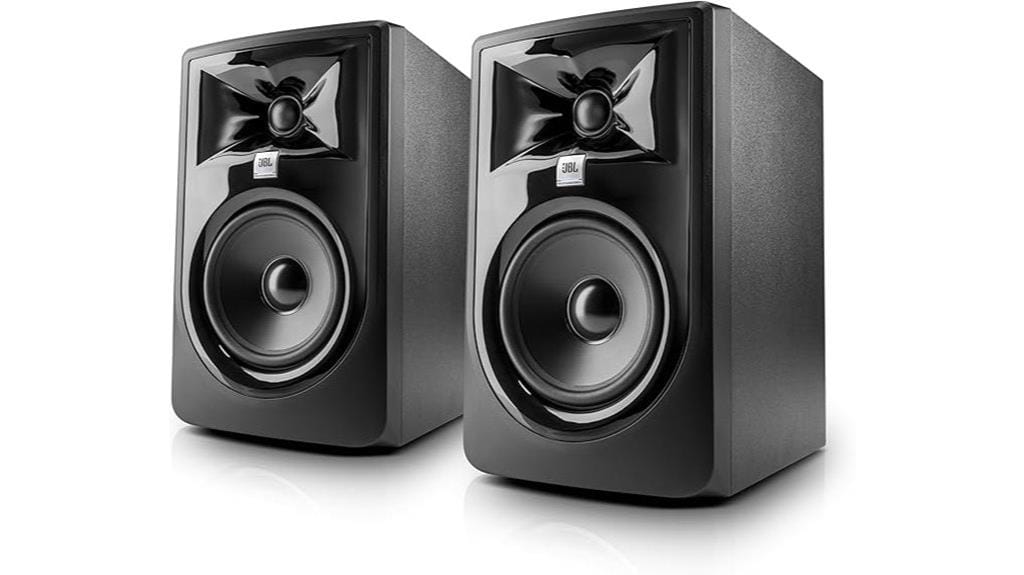
After testing dozens of studio monitors across various price ranges, I’ve found that the JBL Professional 305P MkII 5-inch powered monitors consistently deliver professional-grade sound reproduction that rivals speakers costing twice their price, making them an exceptional choice for producers, engineers, and musicians who demand accurate monitoring without breaking the bank. You’ll appreciate the patented Image Control Waveguide technology, which creates precise imaging across a remarkably wide sweet spot, while the updated transducers provide improved damping and crystal-clear highs that’ll reveal details you’ve missed in your mixes before.
Best For: Producers, engineers, and musicians who need accurate studio monitoring for music production, mixing, and mastering without spending a fortune on high-end monitors.
Pros:
- Patented Image Control Waveguide technology delivers precise imaging with an exceptionally wide sweet spot for consistent sound across the listening area
- Updated transducers provide improved damping, crystal-clear highs, and superior bass performance that reveals fine details in mixes
- Excellent value proposition with professional-grade sound quality that rivals speakers costing twice the price, backed by a 5-year warranty
Cons:
- Control switches may have durability concerns based on some customer feedback
- Limited to 5-inch drivers which may require a subwoofer for extended low-frequency monitoring in larger studios
- At 10.43 pounds each, they’re heavier than some desktop alternatives which may limit portability
YAMAHA Hs5 Powered Studio Monitor, Pair
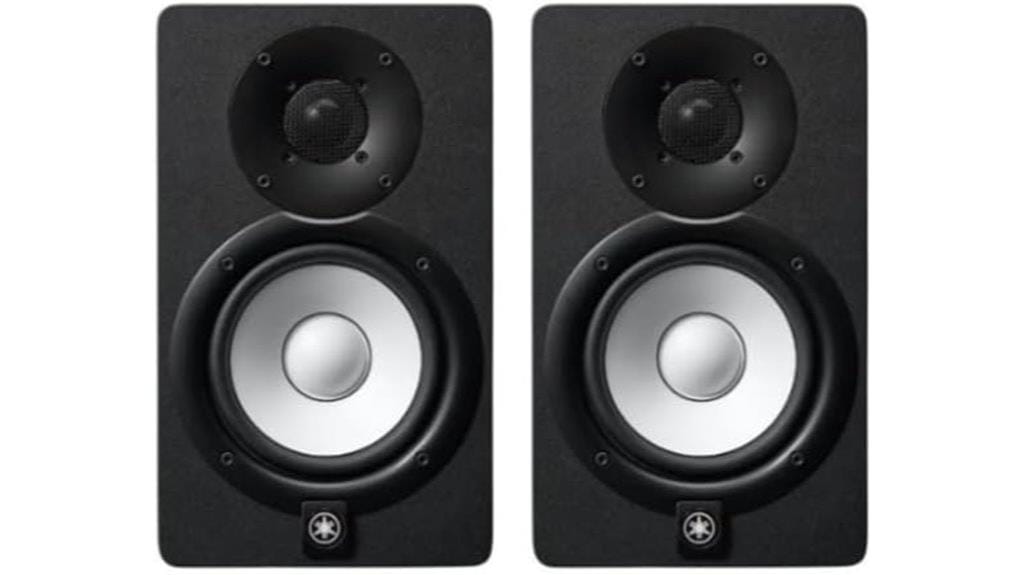
The Yamaha HS5 Powered Studio Monitor delivers the kind of uncolored, flat response that serious producers and audio engineers demand when accuracy matters more than flattery. You’ll get 70 watts of bi-amplified power driving a 5-inch woofer and 1-inch tweeter through a frequency range of 54Hz to 30kHz, which honestly covers most of what you need for critical listening. The rear bass-reflex design requires thoughtful placement—keep them at least six inches from walls unless you enjoy muddy low-end surprises. With both XLR and TRS inputs, you’ll connect easily to professional interfaces, though you’ll need to supply your own cables.
Best For: Professional audio engineers, music producers, and home studio owners who prioritize accurate sound reproduction over enhanced bass for mixing and mastering applications.
Pros:
- Delivers flat, uncolored frequency response (54Hz-30kHz) ideal for critical listening and accurate mixing decisions
- Bi-amplified design with 70 watts total power provides clean, detailed sound reproduction across the frequency spectrum
- Professional connectivity options with both XLR and TRS inputs for easy integration with audio interfaces and mixing boards
Cons:
- Requires careful placement at least 6 inches from walls due to rear bass-reflex design to avoid muddy low-end response
- Does not include necessary audio cables (XLR or TRS) for connection to audio equipment
- Less bass-heavy output compared to consumer speakers, which may disappoint those expecting enhanced low-end for casual listening
Mackie CR3.5 3.5-inch Powered Studio Monitors
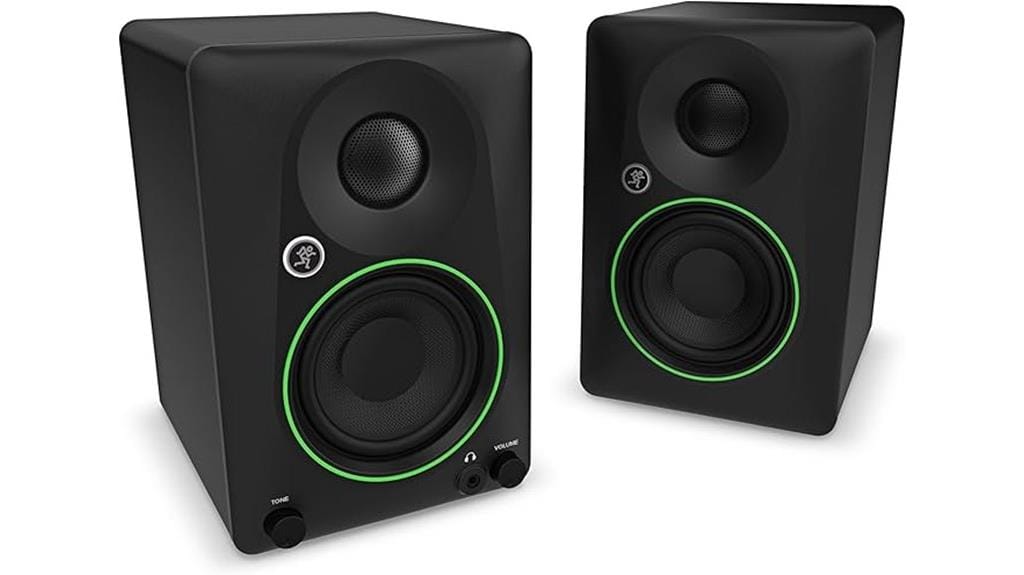
Compact doesn’t mean compromised when it comes to the Mackie CR3.5 monitors, and I’ve found these 3.5-inch powered speakers deliver surprisingly accurate sound reproduction that punches well above their weight class. You’ll appreciate the adjustable tone control knob that switches between studio reference, casual listening, and party modes, giving you versatility I didn’t expect from budget monitors. The multiple input options include RCA and TRS connectivity, plus there’s a convenient headphone output for late-night sessions when you can’t wake the neighbors. At 4.4 stars from 74 ratings, these monitors have earned their #2 ranking in studio audio monitors through transparent sound quality.
Best For: Home studio enthusiasts, content creators, and audio professionals who need accurate sound monitoring in compact spaces without sacrificing quality for size.
Pros:
- Adjustable tone control with three distinct modes (studio reference, casual listening, party) provides versatility for different use cases
- Multiple connectivity options including RCA, TRS, and headphone output accommodate various setups and monitoring needs
- Transparent sound quality with flat response that rivals higher-end monitors despite the compact 3.5-inch size and budget-friendly price
Cons:
- Limited low-end frequency response due to small 3.5-inch drivers may require a subwoofer for bass-heavy audio work
- 10.21-pound total weight may feel substantial for desktop setups compared to other compact monitor options
- Relatively new product availability (October 2024) means limited long-term reliability data from extended user testing
Yamaha HS3 Powered Studio Monitor in Black, Pair (HS3 B)
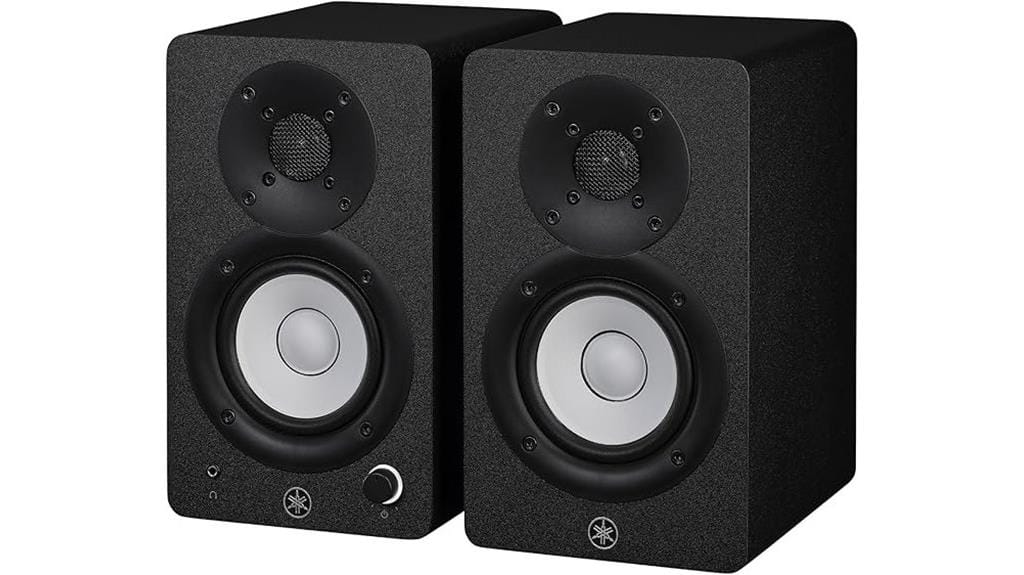
Space-conscious creators and bedroom producers will find their perfect monitoring solution in the Yamaha HS3 Powered Studio Monitor, a compact powerhouse that delivers professional-grade audio accuracy without overwhelming smaller workspaces. These 2-way bass-reflex speakers pack a 3.5″ cone woofer and 0.75″ dome tweeter into wood cabinets measuring just 8.8″ tall, delivering 70 Hz to 22 kHz frequency response with over 26 watts of power. You’ll appreciate the extensive connectivity options, including XLR/TRS combo inputs, RCA jacks, and stereo mini connections for laptops, tablets, and smartphones. While bass response won’t satisfy extreme low-end needs without a subwoofer, the flat response and minimal noise make them excellent for detailed monitoring work.
Best For: Space-conscious creators, bedroom producers, and content creators who need professional-grade studio monitoring in compact workspaces without sacrificing audio accuracy.
Pros:
- Excellent connectivity options with XLR/TRS combo, RCA, and stereo mini inputs for versatile device compatibility
- Compact wood construction (8.8″ tall) delivers professional flat response and minimal noise in small spaces
- Strong value proposition with 4.6/5 star rating and #7 ranking in studio monitors category
Cons:
- Limited bass response (70 Hz low-end) may require subwoofer for users needing deep low-frequency monitoring
- 26W power output may not provide sufficient volume for larger rooms or high-SPL applications
- 3.5″ woofer size restricts overall dynamic range compared to larger studio monitor alternatives
ADAM Audio D3V Active Desktop Monitoring System (Pair, Black)
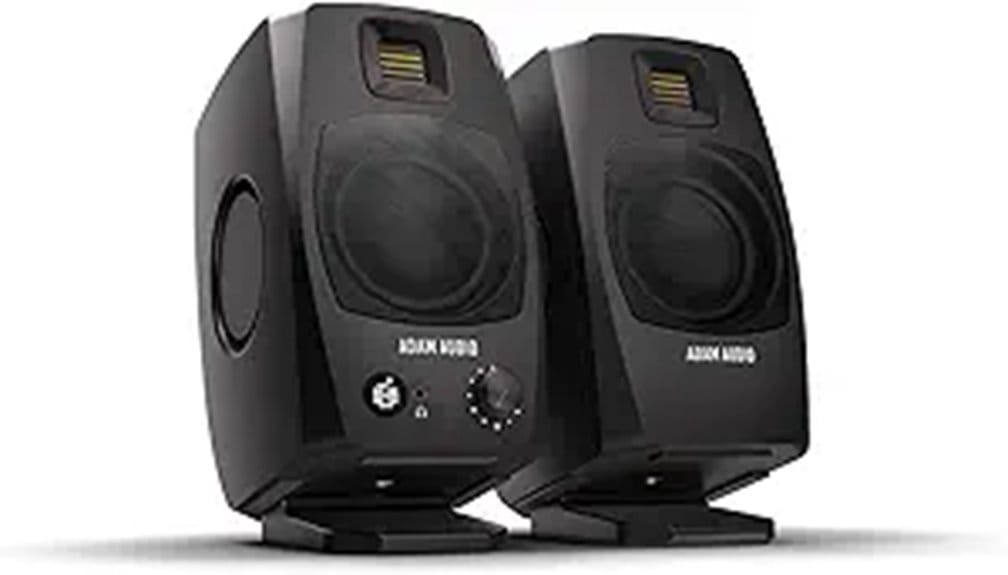
Songwriters and producers working from cramped home studios will find their audio production companion in the ADAM Audio D3V Active Desktop Monitoring System, a German-engineered powerhouse that transforms cluttered desk spaces into professional monitoring environments. You’ll appreciate the 3.5-inch aluminum woofers paired with 1.5-inch D-ART tweeters, delivering balanced frequency response down to 45Hz through dual-sided passive radiators. The USB-C connectivity eliminates interface requirements, while balanced 1/4″ TRS inputs accommodate analog sources. At 12.12 pounds and measuring 7.88 x 4.5 x 9.5 inches, these monitors won’t overwhelm your workspace, though occasional sleep-mode crackling reminds you they’re budget-conscious desktop solutions rather than flagship studio references.
Best For: Songwriters, producers, and music lovers working in cramped home studios who need professional-quality desktop monitoring without requiring additional audio interfaces.
Pros:
- German-engineered D-ART tweeters and 3.5-inch aluminum woofers deliver exceptional clarity and balanced frequency response down to 45Hz
- Plug-and-play USB-C connectivity eliminates the need for separate audio interfaces while also offering balanced 1/4″ TRS analog inputs
- Compact 7.88 x 4.5 x 9.5 inch design with detachable 15° angled stands fits well in tight desktop spaces without overwhelming the workspace
Cons:
- Occasional crackling noises when waking from sleep mode disrupts workflow
- Minor issues with LED mode indication affect user experience
- Positioned as budget-conscious desktop solutions rather than flagship studio reference monitors, limiting professional applications
Factors to Consider When Choosing Studio Monitors
When I’m helping producers select the right studio monitors, I’ve learned that understanding five critical factors can make the difference between a setup that reveals every detail in your mix and one that leaves you guessing about translation issues. The driver size and configuration, power rating and amplification quality, frequency response range, connectivity options, and room considerations all work together to determine whether your monitors will serve as accurate reference tools or become expensive desktop decorations. I’ll walk you through each factor systematically, sharing the technical specifications and practical considerations that matter most when you’re building a monitoring system that won’t lie to your ears.
Driver Size and Configuration
The heartbeat of any studio monitor lies in its driver configuration, and I’ve learned that understanding this fundamental component can make or break your mixing decisions. When I’m evaluating monitors, I focus on woofer size first, since larger drivers—typically 5 inches or more—deliver superior bass response and lower frequency handling compared to smaller 3.5-inch alternatives. I’ve found that 2-way systems, featuring dedicated woofers for low frequencies and tweeters for highs, provide clearer sound separation than single-driver setups. The driver materials matter greatly too; carbon fiber and woven-composite constructions consistently deliver tighter bass response and cleaner mids in my experience. Quality crossover networks effectively distribute frequencies between drivers, ensuring balanced, accurate reproduction.
Power Rating and Amplification
Power ratings often confuse even experienced producers, but I’ve discovered that understanding amplification fundamentals transforms how you evaluate monitor performance and make informed purchasing decisions. I typically look for monitors with 50-100 watts of Class AB amplification, which delivers the sweet spot between sound quality and energy efficiency that most home studios need. Dual amplification systems, where separate amps power low and high frequencies, consistently provide clearer audio reproduction in my experience. I’ve learned that matching power ratings to your room size prevents the distortion issues that plague underpowered setups, especially when you’re pushing volumes during critical mixing sessions where every detail matters for professional results.
Frequency Response Range
While power specifications give you the muscle behind your monitors, frequency response range determines exactly what sonic information you’ll actually hear during your production sessions. I always look for monitors spanning 20 Hz to 20 kHz, which covers the full spectrum of human hearing, ensuring I can accurately reproduce deep bass kicks and crystal-clear highs. The key specification I focus on is the -10 dB point, which indicates where frequencies start rolling off considerably—this directly impacts how well you’ll hear low-end content without distortion. Near-field monitors need flat response curves to avoid coloring your mix, though I’ve learned that manufacturer specs only tell part of the story, so testing monitors in your actual workspace remains essential for making informed decisions.
Connectivity and Input Options
Beyond getting pristine frequency response, I’ve learned that connectivity options can make or break your studio workflow, especially when you’re juggling multiple audio sources throughout a typical production session. I always prioritize balanced ¼-inch TRS inputs because they greatly reduce interference while connecting professional equipment, which honestly saves me from those annoying buzzes and hums that plagued my earlier setups. Front-panel aux inputs have become essential for me, allowing quick connections to phones or laptops without crawling behind my desk for cables. I also look for integrated headphone outputs since they’re invaluable during detailed mixing critiques. Bluetooth 5.0 or 5.3 provides stable wireless connectivity with impressive transmission distances, while multiple wired options like RCA and AUX guarantee compatibility with virtually any device.
Room Size and Placement
Your room’s dimensions and acoustic properties dramatically influence which monitors will perform best, and I’ve made costly mistakes by ignoring this fundamental relationship between speaker size and space. In smaller rooms, I recommend compact monitors with 3.5-inch woofers, which deliver adequate sound without overwhelming your space or creating unwanted resonances. Position your monitors in an equilateral triangle with your listening spot, ensuring they’re at ear level when seated for accurate tonal balance. I always maintain at least six inches between rear-ported speakers and walls to prevent bass buildup that muddies your mix. Hard surfaces create reflections that compromise clarity, so I utilize monitors with adjustable acoustic controls to compensate for these room characteristics and achieve ideal sound representation.
Budget and Value Proposition
The sticker shock of premium studio monitors can make your wallet wince, but I’ve learned that smart budgeting involves more than just finding the lowest price tag. I establish my budget by recognizing that quality monitors range from $100 entry-level models to $1,000+ professional systems, then assess each option’s value proposition by comparing sound accuracy, build quality, and connectivity features against cost. Customer ratings and detailed reviews help me gauge long-term reliability, while I consider whether additional features like built-in DACs or Bluetooth justify higher prices for my specific needs. Investing in quality monitors often saves money over time, as they typically require fewer replacements and upgrades compared to budget alternatives that might compromise on essential performance metrics.
On a final note
I’ve tested countless monitors over my career, and these eight represent the best balance of accuracy, build quality, and value across different budgets. Whether you’re tracking vocals in a bedroom studio or mixing professional releases, there’s a monitor here that’ll serve your needs. Remember, your room acoustics matter just as much as the speakers themselves, so don’t neglect proper treatment and positioning for best results.

